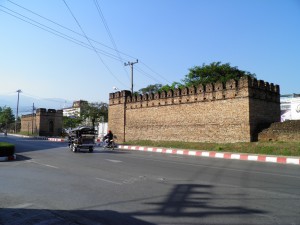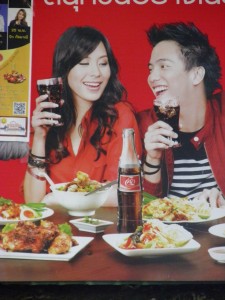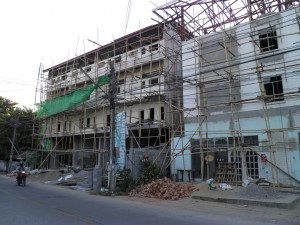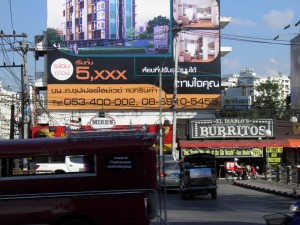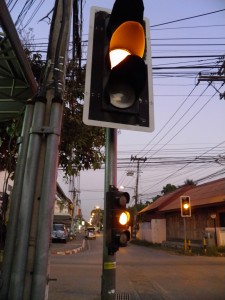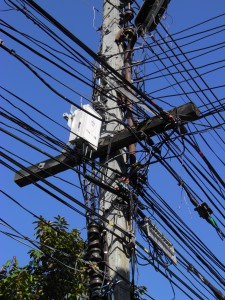Having settled in at Baan Boo Loo overnight and devouring the first of many giant scrumptious breakfasts, it was time to grab the map of the old city of Chiang Mai and start walking. I’m one of those who like following the map but my partner finds it tedious, so I just tried to keep track of where we going as she went about spontaneously. After all, you can never be more than 1 km away as the old city has a surrounding wall and moat. Below is one of the gates . If you have a magnifying glass you can see a Tuk-Tuk and a motorcycle, two of the most common ways to get around in Chiang Mai.
There are also big red taxis like troop carriers and cars which operate as taxis, just as you would have in Australia. It’s a case of using whichever one is most appropriate. The streets are busy and there are intersecting lanes and lanes off lanes. At home I wouldn’t walk down some of these but here I never felt in danger. If the main road is called Warraroot then the lanes are Soi Warraroot 1 etc. The thing is, these lanes are very narrow and the drivers here are fearless and skillful in negotiating traffic, commonly coming head on until they work around each other. I didn’t see a hint of road rage. The population is mainly Buddjist. Orn gave me a succinct summary of what this means; “Don’t disturb yourself and don’t disturb others.” They seem to live by it.
The Thai people love their King, not the elected government, but the Royal family whose images are displayed as giant posters all around. Such is the respect for them that the poster images show a younger King and Queen although they are becoming elderly. The King is best known for popularising the notions of environmental awareness, sustainability and self-sufficiency forty years ago which makes him a visionary trend-setter really.
Everywhere you look, you can see the clash of the old and new. The commercial influence is all pervasive.
Just as it is in Australia, the tearing down of traditional houses in favour of modern buildings is happening apace and is controversial in some quarters. Concrete is the new black. I noticed in the week we were there, a building being made ready to sell motorcycles. The construction was still finishing as the shops were being fitted out. You wouldn’t see that in Australia. Another thing you wouldn’t see is bamboo scaffolding. It’s quite strong and flexible but is only good for six months after it is cut. I hope there’s some good quality control on that! Here’s what it looks like.
Here you can see a typical street scape with the open red taxis.
Crossing the road takes a little getting used to. If you waited for a clearing you’d wait forever. It’s a matter of assertiveness and judgement. All forms of vehicles flow around each other. It’s almost mesmerising. Somehow the locals manage not to have accidents. The only incident I saw was some fellow coming off his moped. He just looked a bit embarrassed and just got back on. There aren’t many pedestrian crossings, but it’s a bit different: it’s not called a Zebra crossing because of the black and white stripes; at a zebra crossing run like a zebra! I found it quite cute that the traffic lights have a smaller set below so the Tuk-Tuk drivers can see them.
I would hate to be a phone technician here. This post is one of the neater ones!
The Tuk-Tuk drivers are assertive but not pushy. Anytime they see a tourist walking they offer their services. They don’t speak English very much, but quoting the name of the nearest temple e.g. Wat Phra Singh gets you close and pointing works from there. Home to Baan Boo Loo.
